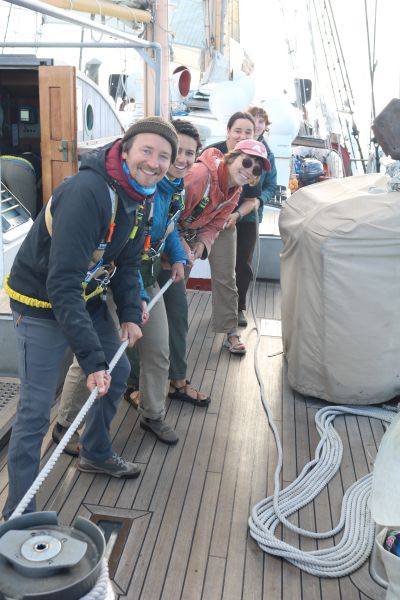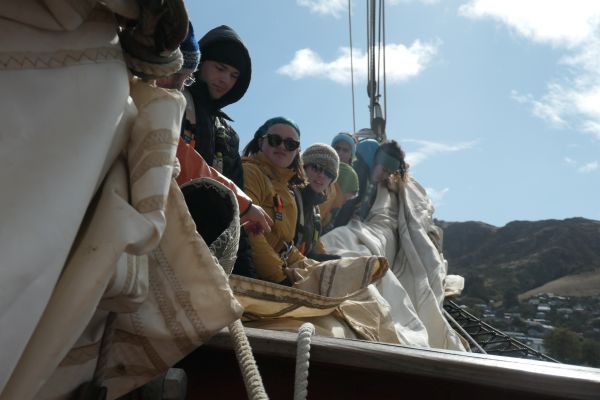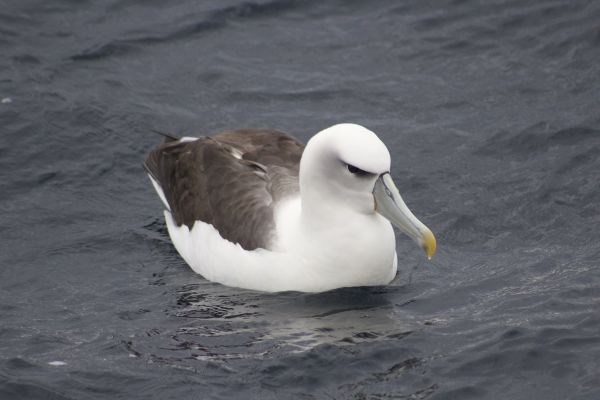Mostly Brooke Levan, kinda Cam Ragland.
March 20, 2024
Author:

Ship's Log
March 19, 2024
Position: Anchored near Lyttelton Harbour
The lack of blog posts these past few days has been a direct result of the
energy poured into so many intense areas of shipboard life recently.
Apologies to the folks at home. As the program wraps up, so does a semester
worth of academic work, the rush of and energy that comes with JWO, and the
high of emotions building as the end is near. The past three days have been
spent day sailing and anchoring with festivities scattered about. Yesterday
was an all-day symposium of event of both oceanography poster sessions and
TED Talks on a variety of topics ranging from the hard hitting subjects of
what defines a home and the meaning of storytelling to tramping culture in
ANZ and the history of Maori protests about the Treaty of Waitangi. We
celebrated so much!
The rest of this blog post is the paper version of the TED Talk that Brooke
gave to the ship’s company yesterday. The TED Talk assignments were all a
letter to someone about a topic that each student felt passionate about.
Brooke’s theme was storytelling and connecting herself, and people before
her to a place. I’ll say there were few eyes left dry in the main salon
after this one.
Dear Grandma,
I hope you and papa are doing well in Carlsbad! I am having lots of fun and
thinking of you both out here in the Pacific Ocean on the Robert C. Seamans.
I think you would really like the ship! It is very different from our
Kinship, but still has lots of great napping spots! Being on the ship has
given me lots of reflection time and space to learn more about myself, my
shipmates, and Aotearoa New Zealand. I have been thinking a lot about our
family and our own stories we’ve told about the water growing up. So many of
our family gatherings have been out at Catalina on the boat. And so much of
our family history traces alongside the coast. It feels special learning how
to read the tides, patterns, and behaviors of an ocean which our family and
ancestors have sailed in for decades. I imagined Great Grandpa Chuck in his
sailor cap, and the stories of you and Papa going out in the blue sailboat
when you first met. I could feel you, papa, and the rest of our family
sailing alongside me throughout my whole journey! The following is some
larger reflections I have been thinking about from this experience that I
thought you might have some thoughts on, (let’s discuss when I’m back in
town!):
Starting this program, I expected myself to be focused on the future.
Looking at how communities are anticipating mitigating increasing threats,
and thinking about how our oceans and its ecosystems will shift with climate
change. With these concepts at the core of our program, I was somewhat
surprised as I found my mind constantly drifting to the past.
In Encinitas, I grew up with the waves at Moonlight, the cliffs at Beacons,
and the tidepools at Swamis beach. Home to surfers, swimmers, and beach
lovers—it is a place where my high school teachers used their free class
period to take surf breaks. The coastline was a constant I took for granted,
and it wasn’t until I moved to a land-locked Oberlin, OH that I began to
truly miss the water. After travelling fifteen hours, to arrive at a foreign
country (I frankly knew little about), I was shocked at the sense of
familiarity that I immediately felt being on the coastline. Arriving to the
Bobby C, after an entire new life, language, and set of responsibilities
were thrown at me, again, I was shocked by the sense of comfort I felt being
on the water, especially being in the Pacific. I found myself reminded of
all that I had learned from these waters growing up. The memories and
stories that the waves held here, all that seemed to have carried over from
San Diego to where I now stood at lookout each day. It had only taken me
moving across the country and flying across the ocean, to ultimately
reconnect with the waters I grew up with.
Through our classes, I begun to learn more about the cultural histories that
flowed through these waters as well. One of our first days of class we read
a poem, Ocean Birth, by Māori poet, Phil Kawana, illustrating the creation
of the Pacific Islands and the people who are indigenous to those lands. The
poem ends by entwining these births—of both land and people together: “Every
wave carries us here—every song to remind us—we are skin of the ocean.” This
entanglement of identity is so strong, the poem’s end considering the ocean
waters to be skin itself. This paired with our following discussion about
the ocean as a social, human place struck me in an unexpected way. While I
grew up so close to the ocean, I have always felt somewhat timid of it—it
was a place not to be tested. I know how powerful the waves can be, how fast
the currents can switch, and how high the tide can rush up along the shore.
We lived at the coast where the ocean was central to my town and explicitly
social. But what lay past the horizon, remained to me something separate.
These ideas of the ocean as a human place continued to come back to me as I
stood on watch. The dark waves crashing against the bow no longer felt as
threatening, they no longer gave the allusion of what seemed like an
unreachable abyss below. Stories started to fill in the space. I began to
see the movement that lived in the waters—the oars that struck the waves,
the shouts of commands moving bows through currents, and the many stories
that lay between where I stood and below what I could see. I began to see
and feel the ghosts of these many journeys that passed over the same places
I now had the opportunity to go.
I further explored these stories on land during our port stops. The Auckland
Maritime Museum and Auckland Museum both gave me more background about the
history of the Pacific Islands. Looking at the details of the boats and
sails that took people from the Tahitian Islands to Aotearoa and reading
about the various navigation methods using the sun and stars, I began to
imagine the incredible journeys taken through the surrounding waters of the
island. The Te Papa Museum further portrayed narratives of Aotearoa’s past.
I especially enjoyed the section that photographed modern trips taken on
historic Māori waka along the coast. These exhibits tied together the ways
that Māori histories and cultural practices are remembered and continued in
current day Aotearoa. In addition, sections of Te Papa paired with the Otago
Settler Museum told versions of the colonist’s story in travelling from
around the world to live new lives in New Zealand. This showcased ships that
more closely resembled our Bobby C and told the story of immigrants like
that told in the US. I thought about our own family history and the voyages
they took across the Atlantic fleeing pogroms in Russia and Hungary in the
early 1900s. Again, I was reminded of the ways that the ocean has carried my
own story from past to present.
These stories soon crept off the shores, out from the waters, and began
following me around the ship. My fellow crewmate and incredible deckhand,
Hillary, shared a poem with me about these very sensations. Cicely Fox
Smith’s poem, Tryphena’s Extra Hand, chronicles the afterlife of a deckhand
sailor who dies at sea. Despite his body being left to the waters, his
spirit remained alive aboard the ship—helping haul the lines, furl the
sails, and helm the ship.
“There’ll be one more at the halyards,
There’ll be one on the yard.
Fisting down them thundering courses when they’re frosted good and hard,
One more tallying on the fore brace
When the waist’s neck deep in foam,
One more hand to sweat the tops’ls up
And sheet t’ga’n’s’ls home.”
Amongst our bustling hub of crew members working our ship, I began to think
about the ghosts of people who had been there in the past. Past students and
staff, and the pieces of their experiences left behind in posters, in our
communal library, and moments shared by current crew members of their
stories. We also had a swirl of our own stories circulating throughout the
ship as we continued to share more time together. We were a hodgepodge group
of crew members, students, and staff all coming from different places,
bringing with us our own intentions and goals for the six shared weeks.
For me, this time at sea has felt just as internal as it has communal. I
have considered my own history with the ocean as well as the many stories I
have overlapped with. I wanted to create a project that represented both
experiences—a story made up from our individual perspectives. I landed on
creating a book to tell this collective story. I asked each S-313 shipmate
for a moment/story that stuck out to them—a piece of their experience which
they will tell and remember. The cover art for the book is a series of
ocean-colored circles, emulating the different waves and waters we sailed
across. Each shared memory is also paired with a single ocean-colored circle
to continue this theme throughout the book. These images paired with the
title “Snapshots of Our Story” aim to visualize each of these perspectives
as a single wave in the collective story we tell. I hope these snapshot
memories will give a feeling of the fragmented story we left on these
waters. Our book will live in the Robert C. Seamans library where future
crew members can share in our memories. This way our story also stays in
motion, navigating through the waters surrounding Aotearoa and the Pacific,
continuously colliding with future moments.
Love to you both, can’t wait to see you when I get home!
Brooke
Brooke Levan
Oberlin College
A Watch

One Comment
Leave A Comment
Mamma Mia, Here We Go Again!
Author: Amelia Lang, C Watch, Barnard College Ship's Log Tuesday, 2 April (again) Noon Position (Lat and Long): 42°18.12’S x 175°62.70’W Ship Heading (degrees): 116° Ship Speed [...]
What’s with all the birds?
Author: Elaina Berdyck, Northeastern University Ship's Log Tuesday, 2 April 2024 Noon Position (Lat and Long): 42°16.8’S x 178°52.5’W Ship Heading (degrees): 065 Ship Speed (knots): [...]
What is Freedom?
Author: Eleftheria-Sofia Dragoti, B Watch, College of the Atlantic Ship's Log Monday, 1 April 2024 Noon Position: 42°57.5’S x 178°26.7’E Ship Heading (degrees): 060 Ship Speed [...]
Ocean 360
Author: Aronah Swartz, C Watch, College of the Atlantic Ship's Log Sunday, March, 31, 2024 Noon Position (Lat and Long): 43°13.0’S x 175°53.8’E Ship Heading (degrees): [...]





We miss you Jordyn Worshek and hope you are having the time of your life! Love Mom & Dad